#Plastic Part Design Optimization
Explore tagged Tumblr posts
Text
DfM vs DfAM: What’s the Right Approach for Your Product Design

When bringing a new product to market, one of the earliest and most consequential decisions you'll make isn't about marketing strategy or pricing—it's about your design approach. The methodology you choose fundamentally impacts everything from production costs and timelines to your product's ultimate quality and performance.
Today's manufacturing landscape presents two primary design philosophies: traditional Design for Manufacturing (DfM) and the newer, increasingly important Design for Additive Manufacturing (DfAM). These approaches represent fundamentally different ways of thinking about how your product will come to life.
For companies seeking design for manufacturing solutions, understanding the distinction between these methodologies isn't just academic—it's essential to your bottom line. Choose incorrectly, and you might face unnecessary costs, production delays, or even design compromises that affect your product's functionality.
In this comprehensive guide, we'll explore:
The fundamental principles behind DfM and DfAM
Critical differences in approach and application
How to determine which methodology fits your specific product needs
Real-world applications in various industries, including medical devices
Integration strategies that leverage the best of both worlds
Future trends shaping design for manufacturing
Whether you're developing consumer products, medical devices, industrial equipment, or specialized components, understanding these design approaches will empower you to make informed decisions that optimize both production efficiency and product performance. Let's dive into the details that matter.
Ready to optimize your product design process? Schedule a consultation call with our engineering team to identify the ideal design approach for your specific needs.
What is Design for Manufacturing (DfM)?
Design for Manufacturing (DfM) represents a traditional but highly refined approach to product development that focuses on optimizing designs for efficient, cost-effective production using conventional manufacturing methods. This methodology has been the backbone of industrial production for decades, evolving alongside manufacturing technologies to create increasingly sophisticated products.
Core Principles of DfM
At its heart, DfM involves anticipating and addressing manufacturing requirements during the earliest stages of product design. Rather than creating a design and then figuring out how to manufacture it (often leading to costly redesigns), DfM integrates manufacturing considerations from day one.
The fundamental principles of design for manufacturing services include:
Material Selection Optimization: Choosing materials that balance performance requirements with manufacturing constraints and cost considerations.
Production Process Alignment: Designing components specifically for the intended manufacturing process, whether injection molding, CNC machining, sheet metal fabrication, or other traditional methods.
Assembly Simplification: Reducing part count, minimizing assembly steps, and standardizing components to streamline production.
Tolerance Management: Designing with appropriate tolerances that maintain functionality while avoiding unnecessarily tight tolerances that drive up costs.
When implemented properly, design for manufacturing solutions lead to products that not only perform as intended but can be efficiently produced at scale with consistent quality.
DfM for Traditional Manufacturing Methods
Different manufacturing processes come with their own design requirements and constraints. Let's explore how DfM principles apply to common production methods:
Injection Molding
Design for Injection Molding requires specific considerations like:
Uniform wall thicknesses to prevent warping and sink marks
Appropriate draft angles for smooth part ejection
Strategic rib placement for structural integrity without excessive material
Gate location planning to minimize visible marks and optimize flow
These considerations are particularly important for high-volume production, where minor design inefficiencies can multiply into significant costs across thousands or millions of units.
CNC Machining
DfM for machined parts focuses on:
Designing geometries accessible to cutting tools
Minimizing the number of machine setups required
Avoiding deep pockets that require specialized tooling
Planning for fixturing and workholding during fabrication
Here's the thing: while these traditional manufacturing methods have significant limitations, they've been refined over decades to achieve remarkable efficiency when designs properly accommodate their constraints.
DfM in Medical Device Development
One area where traditional DfM remains particularly crucial is in DFM for medical devices. The medical device industry faces unique challenges that make thoughtful design for manufacturing essential:
Regulatory requirements demand consistent quality and traceability
Patient safety depends on manufacturing precision and reliability
Sterilization requirements influence material and design choices
High-volume production must maintain exacting standards
For medical device manufacturers, integrating DfM principles early in development helps navigate these challenges while controlling costs. The structured approach of traditional DfM aligns well with the documentation requirements and validation protocols common in regulated industries.
Now let's dive into how additive manufacturing is changing this landscape.
Understanding Design for Additive Manufacturing (DfAM)
While traditional manufacturing methods subtract material (cutting, drilling) or reshape it (molding, forming), additive manufacturing builds objects layer by layer. This fundamental difference requires an entirely different design approach: Design for Additive Manufacturing (DfAM).
Breaking Free from Traditional Constraints
DfAM represents a paradigm shift in how we think about product design. Rather than designing around the limitations of conventional manufacturing processes, DfAM embraces the unique capabilities of additive technologies. This approach offers extraordinary freedom to create previously impossible geometries.
The core advantages of DfAM include:
Complex Geometries: Creating internal channels, lattice structures, and organic shapes that would be impossible or prohibitively expensive with traditional methods.
Part Consolidation: Combining multiple components into single, complex parts to eliminate assembly steps and potential failure points.
Mass Customization: Economically producing variations of a design without the tooling changes required by traditional manufacturing.
Weight Optimization: Developing structures that use material only where needed for strength while minimizing weight in non-critical areas.
What does this mean for you? The ability to reimagine products entirely rather than simply adapting existing designs to manufacturing constraints.
DfAM Principles and Methodologies
Effective DfAM requires understanding both the capabilities and limitations of various additive technologies. Each 3D printing process—whether powder bed fusion, material extrusion, vat photopolymerization, or others—comes with its own design considerations.
Topology Optimization
One of the most powerful DfAM approaches is topology optimization, which uses computational algorithms to determine the optimal material distribution within a design space. This data-driven approach creates structures that:
Maximize strength-to-weight ratios
Distribute stress more effectively
Reduce material usage while maintaining performance
Often result in organic, non-intuitive geometries
Support Structure Considerations
Unlike traditional manufacturing, many additive processes require support structures for overhangs and other challenging geometries. Effective DfAM addresses this by:
Orienting parts to minimize support requirements
Designing self-supporting features where possible
Creating easily removable supports that don't compromise surface finish
Incorporating supports as functional elements of the final design
When DfAM Excels
Design for Additive Manufacturing offers particular advantages in certain scenarios:
Low-volume, high-complexity parts where tooling costs would be prohibitive
Highly customized products tailored to individual user requirements
Lightweighting applications in aerospace, automotive, and other weight-sensitive industries
Consolidated assemblies that reduce part count and assembly complexity
Fluid flow optimization through complex internal channels and structures
Now that we've explored both approaches individually, let's examine how to determine which one best suits your specific project needs.
Choosing the Right Approach: Decision Factors
Selecting between DfM and DfAM isn't a matter of which approach is universally "better"—it's about identifying which methodology aligns with your specific product requirements, production volumes, and business objectives. Here's a systematic framework to guide your decision.
Production Volume Considerations
One of the most significant factors in your design approach decision is the anticipated production volume:
High-Volume Production
For products produced in thousands or millions of units, traditional design for manufacturing solutions often remain the most cost-effective approach. While initial tooling costs for processes like injection molding can be substantial, these costs amortize across large production runs, resulting in very low per-unit manufacturing costs.
DfM excels here because:
Per-part costs decrease dramatically at scale
Process consistency and quality control are well-established
Production speeds for conventional methods typically outpace additive manufacturing
Low-Volume Production
For products with annual volumes in the dozens or hundreds, DfAM often provides compelling advantages:
Elimination of expensive tooling costs
Faster time-to-market without mold creation lead times
Greater design flexibility for iterative improvements
Economic feasibility for customized variants
Geometric Complexity Requirements
The complexity of your product's geometry should heavily influence your design approach:
Simple Geometries
Products with relatively simple geometries—those made primarily of prismatic shapes, uniform wall thicknesses, and limited internal features—often benefit from traditional DfM approaches. These designs readily accommodate conventional manufacturing processes without significant compromise.
Complex Geometries
When your product requires:
Internal channels or structures
Organic, non-uniform shapes
Lattice or honeycomb structures for weight reduction
Consolidated parts with complex interfaces
DfAM provides capabilities that traditional manufacturing simply cannot match, or can only achieve at prohibitive cost.
Material Requirements
Your material selection requirements play a crucial role in determining the appropriate design approach:
Wide Material Selection
Traditional manufacturing offers access to thousands of material formulations with well-documented properties, certifications, and performance histories. If your product requires specific:
Medical-grade polymers with regulatory approvals
High-performance engineering plastics with precise specifications
Materials with specialized characteristics (optical clarity, biocompatibility, etc.)
Traditional design for manufacturing services may provide advantages due to the broader material ecosystem.
Specialized Material Properties
Conversely, additive manufacturing excels with:
Multi-material components
Gradient materials with varying properties
Novel materials specifically formulated for additive processes
Materials with properties tailored through print parameters
Time-to-Market Pressures
Market timing often drives design methodology decisions:
For rapid product development where beating competitors to market represents significant value, DfAM often enables faster development cycles by:
Eliminating tooling lead times (often 8-16 weeks for injection molds)
Facilitating rapid design iterations without tool modifications
Enabling parallel development of multiple design candidates
For products entering established markets where cost optimization matters more than speed, traditional DfM's focus on production efficiency may deliver greater long-term value.
Here's a comparison table summarizing key decision factors:
Factor
Favors DfM
Favors DfAM
Production Volume
High (10,000+ units)
Low to Medium (<1,000 units)
Geometric Complexity
Low to Medium
High
Material Requirements
Standard, well-characterized
Specialized or novel
Time-to-Market
Standard
Accelerated
Cost Structure
Higher upfront, lower per-unit
Lower upfront, higher per-unit
Product Lifecycle
Long, stable
Short, evolving
Hybrid Approaches: Combining DfM and DfAM
The decision between DfM and DfAM isn't always binary. Many successful product development strategies leverage hybrid approaches that combine the strengths of both methodologies. This integration can create powerful synergies that optimize both design performance and manufacturing efficiency.
Strategic Integration Strategies
Effective hybrid approaches typically implement one of several integration strategies:
1. Component-Based Hybridization
In this approach, different components within the same product use different design methodologies based on their specific requirements:
Complex, low-stress components leverage DfAM for geometric freedom
High-stress structural components use traditional DfM for proven reliability
High-volume, simple components utilize conventional manufacturing for cost efficiency
This strategic allocation of design approaches optimizes the overall product while respecting the strengths and limitations of each methodology.
2. Development Phase Hybridization
Another effective approach uses different methodologies at different stages of product development:
Concept development and early prototyping utilize DfAM for rapid iteration
Late-stage prototyping transitions to DfM principles to prepare for mass production
Manufacturing validation uses processes identical to final production
This progression allows teams to maintain agility early while ensuring manufacturability as the design matures.
Case Study: Medical Device Development
The medical device industry provides excellent examples of successful hybrid approaches. Consider a complex surgical instrument development program:
Critical handles and grips are designed using traditional DFM for medical devices to ensure reliable ergonomics and cost-effective production
Complex internal mechanisms leverage DfAM to reduce part count and enable sophisticated functionality
Prototypes use additive manufacturing for rapid testing iterations
Final production implements injection molding for high-volume components alongside selective additive manufacturing for complex subassemblies
This integrated approach delivers a superior product faster than either methodology could achieve independently.
Now let's dive deeper into real-world applications of both approaches.
Real-World Applications and Case Studies
Understanding how DfM and DfAM principles apply in practice helps clarify when each approach delivers optimal results. Let's examine specific applications across different industries.
DfM Success Stories
Consumer Electronics
A leading consumer electronics manufacturer implemented comprehensive design for manufacturing solutions when developing a new portable device. Their approach included:
Material selection optimized for both structural requirements and injection molding process parameters
Design modifications to eliminate undercuts and simplify tooling
Strategic use of snap-fits and self-locating features to reduce assembly time by 47%
Wall thickness standardization to prevent warping and sink marks
The result? Production costs decreased by 22% compared to the previous generation while maintaining premium build quality and reducing assembly defects by over 60%.
Medical Device Manufacturing
A medical diagnostics company applied DFM for medical devices when developing a new point-of-care testing platform:
Components were designed specifically for automated assembly
Material selection focused on biocompatibility and regulatory compliance
Tolerance stacking analysis identified and resolved potential fit issues before tooling
Design validation included manufacturing process simulation
These efforts reduced their production ramp-up time from 9 months to just 7 weeks while maintaining 100% compliance with regulatory requirements.
DfAM Transformations
Aerospace Component Redesign
An aerospace manufacturer redesigned a critical ducting component using DfAM principles:
Consolidated 18 separate parts into a single printed component
Reduced weight by 64% through topology optimization
Improved airflow efficiency by 23% using organic internal geometries
Eliminated multiple assembly operations and potential leak points
The redesigned component not only performed better but eliminated tooling costs and simplified supply chain management.
Customized Medical Implants
A medical device company implemented DfAM to create patient-specific implants:
Each implant is designed using patient CT scan data
Lattice structures promote tissue integration while maintaining strength
Production requires no tooling, enabling economical patient-specific manufacturing
Design-to-delivery time reduced from weeks to days
This application demonstrates how DfAM enables entirely new product categories that would be impossible with traditional manufacturing approaches.
What does this mean for you? The right design approach depends entirely on what you're trying to accomplish—mass production efficiency or design innovation—and sometimes, the best answer involves elements of both.
Future Trends: The Evolving Landscape of Manufacturing Design
The boundary between DfM and DfAM continues to evolve as manufacturing technologies advance and design tools become more sophisticated. Understanding emerging trends helps companies stay ahead of the curve and make forward-looking design decisions.
Artificial Intelligence in Design
AI is transforming both traditional design for manufacturing services and additive approaches:
Generative design algorithms automatically explore thousands of design iterations that balance performance requirements with manufacturing constraints
Machine learning systems predict manufacturing outcomes based on design parameters, enabling proactive optimization
AI-powered design validation tools identify potential issues earlier in the development process
These technologies are breaking down the traditional barriers between design and manufacturing, creating more integrated processes regardless of manufacturing method.
Materials Innovation
Novel materials are expanding the capabilities of both traditional and additive manufacturing:
Advanced composites with engineered properties are becoming compatible with injection molding processes
New additive materials increasingly match or exceed the performance of traditional engineering materials
Multi-material printing capabilities enable previously impossible functional gradients within parts
As material options expand, the decision factors between DfM and DfAM shift from "can it be made?" to "what's the most efficient way to make it?"
Sustainability Considerations
Sustainability is becoming a critical design factor across all manufacturing approaches:
Design for disassembly and recycling is being integrated into traditional DfM principles
DfAM enables material reduction through topology optimization and lattice structures
Lifecycle assessment tools help designers quantify the environmental impact of different design and manufacturing approaches
Forward-thinking companies are finding that sustainable design practices often align with manufacturing efficiency, creating business and environmental benefits simultaneously.
Convergence of Technologies
Perhaps the most significant trend is the gradual convergence of traditional and additive technologies:
Hybrid manufacturing systems combine additive and subtractive processes in single machines
Production lines increasingly integrate both methodologies within unified workflows
Design software bridges the gap between approaches, allowing designers to apply appropriate principles to different features
This convergence suggests that the future won't be about choosing between DfM and DfAM but rather about seamlessly integrating the right approach for each specific design challenge.
Conclusion: Making the Right Choice for Your Product
The choice between Design for Manufacturing (DfM) and Design for Additive Manufacturing (DfAM) represents more than just a technical decision—it's a strategic choice that impacts your product's performance, cost structure, and time-to-market. As we've explored throughout this article, each approach offers distinct advantages for different scenarios.
Traditional DfM continues to excel for high-volume production where cost efficiency and proven materials are paramount. Its structured methodology aligns perfectly with industries requiring regulatory compliance, consistent quality, and established supply chains. For many products, particularly those produced in large quantities, design for manufacturing solutions remain the optimal approach.
Conversely, DfAM unlocks unprecedented design freedom, enabling complex geometries, part consolidation, and customization that traditional methods simply cannot achieve. For low-volume, high-complexity applications or products requiring rapid development, DfAM provides compelling advantages that can transform your approach to innovation.
Many leading companies are discovering that integrating both methodologies—applying each where it delivers the greatest value—creates the optimal development strategy. This hybrid approach harnesses the efficiency of traditional manufacturing alongside the design freedom of additive technologies.
#Design for Injection Molding#DFM for Medical Devices#Plastic Part Design Optimization#design for manufacturing services#design for manufacturing solutions#DfAM
0 notes
Note
pro football player!bllk with girlfailure gf 🙏
“𝐛𝐫𝐚𝐢𝐧𝐜𝐞𝐥𝐥 𝐧𝐨𝐭 𝐟𝐨𝐮𝐧𝐝”

a/n: reader is me i fear because i had apple maps on and turned left when siri said turn right (i ain’t ever living that down)
ft. isagi yoichi, itoshi rin, itoshi sae, nagi seishiro, mikage reo, kaiser michael, shidou ryusei, aiku oliver
isagi yoichi
"i’m not saying you're a disaster, love, but i just saw the smoke coming from the toaster and knew you tried to make soup again."
yoichi is genuinely concerned for your wellbeing on a daily basis. he’s in the peak of his athletic prime – eating clean, training consistently, and optimizing performance… and then there’s you, googling “can i eat expired pudding if i microwave it?”
he keeps track of your life with the dedication of a world cup coach. daily alarms set for you. calendar events for you. a literal google doc titled "how to not die this week – for my girlfriend."
“yoichi, i accidentally took a sleeping pill instead of my vitamin again. at 2pm.” “... okay, stay on the phone while i cancel your dentist appointment and put you in bed.”
when you showed up to one of his games wearing a shirt with his face on it, backwards, he didn’t even blink. he just fixed it for you mid-tunnel entrance like he was adjusting his jersey.
he tells reporters, “she keeps me grounded.” what he means is you walked into a glass wall yesterday trying to wave at a squirrel.
itoshi rin
"you’ve burned water. explain to me how that’s even physically possible."
rin is the definition of organized. you? you just poured orange juice into your cereal because you were “half-awake and the cartons looked the same.”
he constantly looks like he’s asking god why he’s being tested. but despite the judgmental sighs and eternal frown, he never lets anyone else talk down to you.
“i couldn’t figure out how to put gas in the car so i called triple A and cried.” “... i’m going to show you how to do it. we’re going right now. bring your notebook.”
he sets emergency funds aside just for your monthly “life mistake.” like the time you bought a fake designer purse that turned out to be a lunchbox.
but he remembers everything. your favorite candy. how you like your grilled cheese (burnt, apparently). which socks help when you’re overwhelmed.
once you got lost in IKEA and called rin in a panic. he tracked you down like joe goldberg.
itoshi sae
"i make millions a year and my girlfriend just got stuck in a revolving door."
sae is rich, classy, and elegant. you once mistook a bidet for a drinking fountain. opposites, baby.
he acts all nonchalant and "ugh," but he's always silently picking up the pieces after you’ve caused another minor catastrophe.
“i thought the microwave was the oven and now the plastic is part of my dinner.” “okay. i’m ordering sushi. don’t eat it. i mean it.”
he’s weirdly patient with you. will roast you endlessly, but also brush your hair out of your face while saying “idiot” in the gentlest voice ever.
once, you tripped walking up the stadium stairs and spilled a nacho tray onto a stranger. he didn’t even blink. just pulled out his black card and paid for all the ruined food.
“do i like her because she’s cute? no. it’s the comedy. i never know what she’ll break next.”
nagi seishiro
"wait… you were supposed to go to work today? oh no."
you both forgot what day it was and slept through a meeting. your lives are one long nap and an accidental door dash order.
nagi genuinely doesn’t care about your failures. he just kind of blinks and goes “eh, sounds annoying. let’s lie down.”
“sei, i think i broke the vacuum.” “cool. guess we don’t clean now.”
you once forgot to bring your passport to the airport. he forgot his shoes. you were that couple. the airline staff pitied you.
he lets you stack your chaos on top of his. gets a little spark in his eyes when you mess something up. “you’re funny,” he says as you spill water on your laptop.
surprisingly supportive. doesn’t fix things, but he’ll cuddle you while you cry about them.
“i ruined the job interview.” “eh. next one. let’s get ice cream.”
mikage reo
"my baby can’t do taxes or read maps, but she’s hot so it’s fine."
he’s so ridiculously rich and competent, and you’re just trying to remember your email password from middle school.
constantly watching you with an amused expression like “wow. she’s really out here giving it her best. adorable.” like you said “i think i wanna become an astronaut” and he started looking up NASA internships.
“reo, i tried to meal prep and now there’s rice in the ceiling fan.” “that’s talent. you want a private chef?”
he buys you a new phone every time you drop one in the toilet. it’s happened four times.
he sends you voice notes like “baby, remember to eat today” and you reply “does chocolate count?” and he’s like “only if you eat six.”
will absolutely drop $30k on something to make your life easier and then call it a “just because you’re a princess” gift.
kaiser michael
"schatz, why are you crying?" "i tried to braid my hair and now there’s a comb stuck in the wall."
kaiser is such a showoff. pro athlete, media darling, good with money, sharp as hell. you? you tried to fix the wi-fi by blowing on it like a nintendo cartridge.
he lives for your mess. he thinks it’s hilarious. he’ll walk into a room you destroyed and be like “wow. modern art. you’ve outdone yourself.”
“kaiser, i accidentally sent my manager a meme instead of my availability.” “did they laugh? no? then resend with context.”
he’ll bully you for your mistakes but then drop everything to help you anyway. “you’re lucky i like you. and that you look hot when confused.”
secretly addicted to you needing him. will pout if you fix something yourself.
“you didn’t call me when your sink broke?” “i googled it.” “what the hell. i was emotionally prepared to be your hero.”
shidou ryusei
"guess what i just did!" "lit something on fire?" "how did you know!?"
you two are absolute chaos. you keep failing at life and he cheers you on like it’s a sport.
“i just sent an angry email to the wrong person.” “HELL YEAH BABY. make it worse! want me to reply with a meme?”
he loves how you panic over small things while he eggs you on. “i lost my shoe!” “go barefoot! embrace the primal life!”
he brings out your most unhinged side and encourages your impulsive decisions. “should i dye my hair pink?” “only if you let me do it with kitchen bleach.”
somehow, when you’re both together, things work?? the disasters cancel out??? or at least no one’s bored.
“she’s dumb, and she’s mine. and if anyone says anything else i’ll headbutt them into next week.”
aiku oliver
"you’re not a failure. you just have a very… creative approach to life. and gravity."
he’s the charming, cocky pretty boy captain and you once fell down an escalator because you were texting.
he calls you “baby” in that teasing voice every time you mess something up. “baby… you really locked yourself out again?” “yes…” “adorable. hold on, let me come save your helpless little ass.”
literally spoils you rotten to compensate for your chaos. you messed up your entire skincare routine and he booked you a five-star spa appointment.
jokes that you’re his "clumsy little gremlin" and kisses your forehead after you bump into a pole.
also weirdly proud of your fails. tells his teammates about them like fun facts. “my girl once put dish soap in the laundry machine. we had bubbles for hours."
he likes that you need him. not in a weird possessive way, just in the fun way.
“she keeps life spicy. also, she accidentally started a fire once by microwaving foil.”
© 𝐤𝐱𝐬𝐚𝐠𝐢
#blue lock#blue lock x reader#bllk#bllk x reader#blue lock headcanons#isagi yoichi x reader#yoichi isagi x reader#rin itoshi x reader#itoshi rin x reader#itoshi sae x reader#sae itoshi x reader#nagi seishiro x reader#seishiro nagi x reader#mikage reo x reader#reo mikage x reader#kaiser michael x reader#michael kaiser x reader#shidou ryusei x reader#ryusei shidou x reader#aiku oliver x reader#oliver aiku x reader#braincell not found
600 notes
·
View notes
Text
Fionna and Cake theory: Simon the Artist

Nothing like a good old creative panic attack.
Fionna and Cake good. Haven’t been excited about a show like this in a long time, though it being a part of Adventure Time does help quite a bit. I was holding on to some cautious optimism for the show when it was announced as yet another big IP series covering the multiverse (still waiting to groan at THAT scene where Prismo has to explain to us about there being infinite universes), but as usual, Adventure Time’s crew continues to surprise me with its creativity, humor, and thematic resonance.
The most striking part about Fionna and Cake so far is just how deliberately the show wants us to differentiate it from the original Adventure Time.
We’re getting shots where Simon pops an artery from his arm, a theme song that explicitly talks about suicidal ideation, discussions of rent and financial problems, and curses no longer disguised with AT’s usual dialogue. Adventure Time has always had violence, thematic density, and juvenile rating pushers, but they were always reserved at small points. Meanwhile, these are factors that are just casually shown and discussed in Fionna and Cake every 3 minutes or so. This is not an all-ages miniseries, it’s for young adults. (hint: this will be relevant later)
Let’s get right into it. This is much less a speculative lore theory and more on what thematic direction the story may be going.
Before we do, let’s get this out of the way first. This theory assumes that the current Fionna and Cake world is all a part of Simon’s head and not merely a separate multiverse, which… I’m certain is fact for the following reasons.

The immediately obvious piece is that Fionna and Cake was always the Ice King’s fanfiction. Now if you’re versed in AT’s continuity you’re probably going to be asking about the red light in Fionna and Cake + Fionna and… I’ve no answer for it unfortunately. It’ll probably be relevant later in the series and possibly age this post like milk but for now, we’re not here to focus on the how, but the why.

Second is that the intro and the ending of Ep 2 literally show Fionna’s world spilling right out of Simon’s head like an animated world out of a frozen brain. If that isn’t clear enough-


Didn't realize this until writing, but these glasses are just plastic made to look like Betty's
There’s no other explanation for this other than that this world is artificial or influenced by Simon in some sense. Fionna even specifies that the statue went under renovation 12 years ago, but nobody seems to know who it is. Considering how Finn looks in the episode, it’s likely that it’s been that long since Betty’s sacrifice in the finale.
With that out of the way, here it goes.
The reason Fionna and Cake exist in the first place is because the creators found Natasha Allegri’s genderswap designs charming and wanted an in-universe reason to use them the Ice King wanted to create trashy, wish fulfillment through art. It was a phase.

Definitely changed that image for publishing.
Simon can argue if they’re good or bad but it’s undeniably his art. It’s not just a portfolio he left behind in a closet, it’s an experience that was shared with a larger audience.
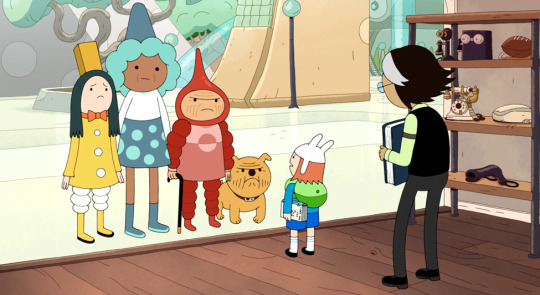
And even if wasn’t liked at first, the citizens of Ooo seemed to have come around to it. And some of them love it!
Whether Simon likes it or not, he has a fan base that is so endeared to the story he made all those years ago that they demand he makes more. Why let a good story, loved by many, go to rest when you still have some life and creativity left in you?
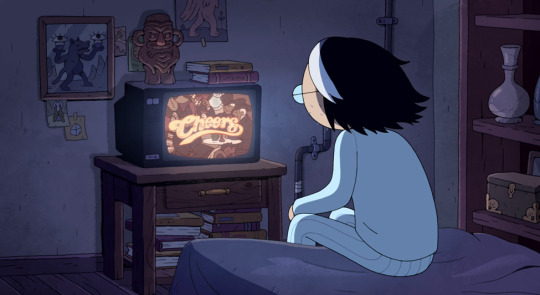
Can't move on in more ways than one.
Except, the problem is that Simon isn’t Ice King anymore. He’s aged out of it.
His real passion is history, he's an adult who who finds passion in the mundane and antiques from the past. And frankly, there isn’t much room for wish-fulfillment and fantasy anymore. Simon has responsibilities. He has a job and a daughter in a world that is moving faster than he can process.
And where Ice King wrote about looking for love, Simon has already had it.

And lost it. His mind isn’t focused on the rosiness of finding new love, it’s grieving the one he already thought was the one.
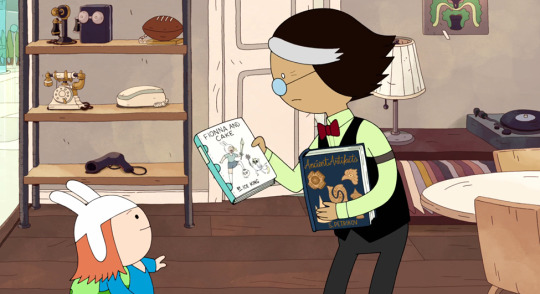
Wasn't he supposed to be good with kids?
Despite his new life experiences, all his peers seem to want from him is to make more of what they’re familiar with.
A story made from wants and wishes that he doesn’t even have anymore.
A story that was literally made by someone else at a different time. It’s a fiction he cannot connect to anymore, art that he’s embarrassed by. Yet also jealous of. Because at one point, the body Simon used to be in understood what exactly was missing from his life and could express that easily.
Seeing it again is like experiencing a retrospection of a cringey loser you don’t want to imagine having ever been. It’s not you anymore, and you don’t want to be reminded of that.

Because despite him having a new creative passion, no one seems to care about that. All they want is Fionna and Cake. And what is more lonely than other people misunderstanding what you’re trying to express?
If I failed to make it clear somehow, my theory is that: Simon’s relationship with Fionna and Cake is a metaphor for creators growing out of their art. And this new Fionna and Cake world is still comfort art born out of Simon’s current desires and perceptions.
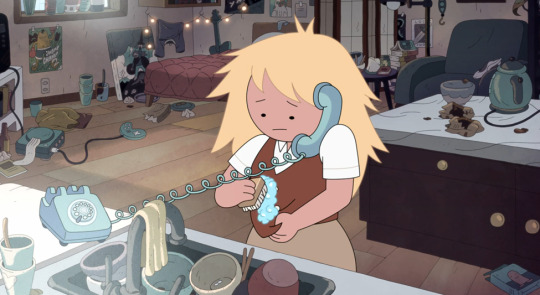
The snippet subtitles this “child holding a phone”. I guess I’m wrong. Essay over.
Episode 1 and 2 both have direct parallels with each other. They’re both about a protagonist who are feeling displaced from their world, living a phase of losing a significant other, leaving a thankless job, wearing a mask of stability in front of the people they care for, seeking a guru at the heart of the forest, and concluding that they no longer belong in their current world.

But more importantly, Fionna and Cake (the characters, the world, and the show) are no longer for an all-ages crowd. Fionna and Cake now feature young adults, curses, gore, alcohol, partial nudity, financial issues, morning routines, mid-life crisis, and overt suicidal ideation. These are the feelings that Simon relates to and possibly desires to express through art. Thus, his story and our new miniseries have warped that way.
Am I overthinking this? No. How dare you assume that.
Is equating the unconscious writings of his dementia-ridden self to Simon as his younger self seem a bit odd? ….Kinda. Again, it’s not the how but the why that matters in this case. I'm NOT crazy, I have proof that there is some acknowledgment of this directly in the show.
Rewatch the bar scene and apply this reading of the episode to what Simon says there:
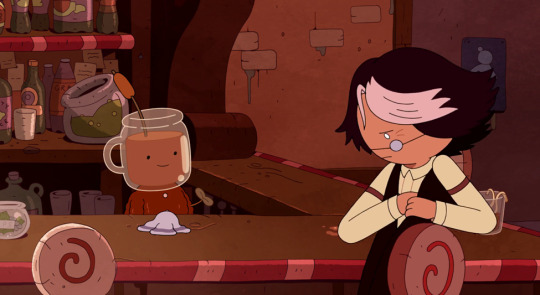
“Your old stuff, Fionna and Cake, honest to glob my man, is an inspiration to me.”
“My old stuff, I don’t really want to talk about my old stuff…”
“Why not? You should be proud! You wrote an entire extended universe in a fugue state if you think about it.”
"Simon cringes"
If you have ever shared art with a group of people in the past, you’ve had this conversation.
Not likely, not possibly, no perhapses. You HAVE.
And Fionna and Cake being an epilogue to a massive award-winning, near-decade-spanning, cultural sensation 5 years after it ended, might result in its creators feeling very retrospective about what audiences want from them now.
And how difficult it’s going to be to tell new experiences and tones from what’s come before. Also, come on. “Extended Universe?” That doesn’t sound like Fionna and Cake. That sounds a lot like something else.
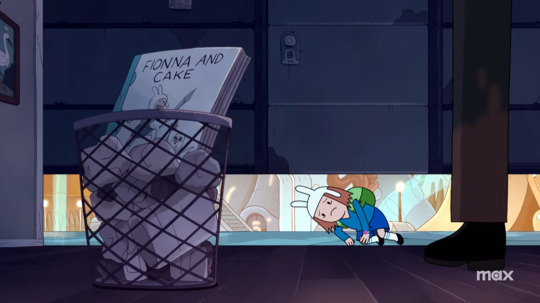
Again, seems bad with this kid.
One of the more profound shots in the main trailer for the show features the inconspicuously Finn-like kid crouching at her Fionna and Cake book in Simon’s trash. I believe this character is going to have a major role in two ways. Convincing Simon to be proud of what he’s accomplished and/or embracing that Simon wants to move away from his original work in order to create something new, or perhaps more likely, reinvent Fionna and Cake into what Simon relates to now.
We’ll just have to see what Simon thinks of his new Fionna next week.
PS. Talking as a fan now, WHAT IS UP WITH THE 1000+ TREEHOUSE IN THE INTRO?!!! ARE WE REVISITING THIS TIMELINE AGAIN?

SOMEONE TELL ME NOW!!!
#television#adventure time#fionna and cake#simon petrikov#fionna campbell#animation#speculation#theories#fan theory#character analysis#discussion#adventure time spoilers#fionna and cake spoilers
561 notes
·
View notes
Note
5 facts about Moth Wizard that you find important? or your top 5 characters? 👀
Hi sorry this took a while, keeping it within a reasonable length and on topic was a challenge but I'm really happy with how it turned out and it was a lot of fun! Thank you for the ask!!
5 Moth Wizard Facts:
1. The General Setting
Moth Wizard takes place hundreds of years in the future and the setting is a mix of optimism, dreams to help me cope with the present, and justification for the post-apocalyptic fantasy aesthetic. This includes "mildly utopian" settlements being common globally, prehistoric dinosaurs roaming the Earth, and a lot of overgrown ruins of the modern world. The rotting corpse of capitalism itself. One day all the concrete will be dust and even plastic will learn to decay, but we will still be here, building something better.
2. A Precious "Detail"
The most important (to me and to the characters) and self-indulgent piece of dreaming a better future is not actually going to be plot relevant much. The Third Temple stands in Jerusalem. Despite everything, after more than two thousand years of persecution in exile, the Jews survived, made it home, and thrived. Opinions differ on whether to finish painting your house.
3. The Apocalypse
If it's "post-apocalyptic" there must have been an apocalypse to be post. Looking at what's become of the world in recent years I'd say it's already started in our time. Ours will hopefully somehow change course but theirs didn't. Things only escalated until the flames burned out. And the world would never see such horrors again. But importantly, it was not worth it. Billions of people died, countless ecosystems destroyed and species lost, many large parts of the world rendered uninhabitable to most life. It didn't have to go this way. A rainbow above the ashes. This was not justice. Everything we built in the ruins was built in spite of what happened.
4. Magic
The magic system is designed such that, in theory, anyone could use it to do almost anything. In practice, it requires a very specific mindset, focus, and (if one wants to do it with any consistency and accuracy) a lot of practice. The most important factor, in what actually happens when attempting to do magic, is expectation. Trying to cast a fireball will never result in ice cubes, but it can result in nothing happening except embarrassment of the caster, if they are not fully convinced that they will, in fact, cast a fireball. Even considering what to do in case a spell fails can cause the spell to fail. This is why most wizards tend to specialize, really knowing what your Thing is and that it always works really helps make it always work.
5. Moth Wizard in the Narrative
The titular Moth Wizard himself is an autistic Jew and his role in the story, as I plan to tell it, doesn't easily fit into categories like "protagonist". Moth Wizard is supposed to be sort of like an anthology. A collection of almost unrelated stories, which, if analyzed in isolation and purely as a series of events rather than a specific narrative, would each have different main characters. The thing they would have in common is that Moth Wizard would be there as a side character, someone helping the protagonist with their goal. But the way I plan to tell these stories with clear main characters is following Moth Wizard's perspective. But not entirely taking his perspective either. It is not a story we see through his eyes. You can think of it like a nature documentary, with David Attenborough following the side character life of this peculiar moth... wizard.
Thanks again for the ask!! :3
#ask the tooth folk#ok to reblog#sfw#personal#viktorsbedpartner#Moth Wizard#You Will Be Seeing This Post Again#tw war#cw war#war cw
15 notes
·
View notes
Text
Game Review: Factorio: Space Age (pt 2)
This is the second part of my review of Factorio: Space Age, covering the planets. This will have more spoilers than the previous section, but also include more cohesive thoughts on the expansion as a whole.
Vulcanus
Once you've built a spaceship, you have a choice of three planets to go to, and you can do them in any order you'd like. Each planet comes with its own researchable rewards, which require you to build up a base on the planet capable of making a science pack and shipping it into space (or alternately, to remake all sciences on the planet, but this is stupid and pointless given what lies further down the tech tree).
I chose Vulcanus first. There are five resources here, three of which can't be found anywhere else: coal, sulfuric acid, calcite, tungsten ore, and lava. Lava gets used to make anything having to do with copper and iron using the foundry, which is most of the things in Factorio. Sulfuric acid gets used with calcite to make water, which is one of the notable things missing from Vulcanus, along with oil. Plastic requires a long chain to make: coal liquefaction into heavy oil into light oil into petroleum into plastic. Because rockets require plastic twice (LDS and blue chips), you eventually need to set up a fairly sizeable build for this.
I didn't find any of this to be too interesting. Infinite resources are at least different, but there was nothing that fundamentally changed how I view the game, and I ended up setting up a bus with more fluids than usual, mostly making on-site plates, pipes, steel, etc. The art for it is cool, and impassable lava is at least a little constraining, but I didn't feel like it was all that great.

Tungsten ore is the main material from Vulcanus, and it's defended by the other major thing that makes the place unique, the worms. Each worm has a territory, and until you've killed your first worm, you don't have access to a tungsten ore patch, only loose scraps that have been laying around.
The worms are long and segmented, very distinct from the biters. They disable electronics with their attacks, making fountains of lava beneath you, and overall I think they're cool ... except that they're a little too easy to defeat. I set up a grid of 50 turrets with armor-piercing ammo, and that proved sufficient.

This is a boring solution. I wish it didn't work. It was the first thing I tried, and afterward I thought ... well, what was the point of that? I don't have a good solution to what you'd want to do to stop this from working, but I do think this is sort of bad design, since it's a "more dakka" solution. I've also seen that you can build a tank and take one out with a single uranium shell, which is even worse design. What I wanted was a fight were I needed to use poison capsules, land mines, strategically placed turrets, etc., some kind of mixed-asset offensive package, and what I got was fifty turrets in a stupid grid. I really do try to not be one of those players that optimizes myself out of having fun, but it's hard to motivate myself to do something the pointlessly hard way when there's something simple, easy, and foolproof.
The other thing about demolishers is that they have their own territory, and that territory never changes. This means that if you want to expand beyond a relatively modest starting patch, you need to kill them ... but unless you're going for a megabase, you don't need to kill more than three or four of them across the entire time playing the game, and since they only attack if you build in their territory, those worm encounters become like 1% of the Vulcanus experience.
I would have liked if the worm territories changed. I think it would have been cool if they fought each other for dominance over an area in a way you could capitalize on, or if they would expand into places that no one had claimed, or places a dead rival had left behind. It would have been cool to require the player to build up some do-nothing machines or other infrastructure to keep the worms back, like a sort of "build this at the edge of your territory to be in constant motion to convince the worms that it's occupied" type of thing. But instead, you just kill the worms and that's that, you never see them again unless you go hunting them. According to my end-of-game statistics, I killed 8 small demolishers and 2 medium demolishers, which was probably 5 more worms than I needed to kill, since I ended up with a lot of empty space I didn't do anything with.
So overall, Vulcanus is the weakest of the planets for me, and I think that's at least partly down to the under-use of the worms and the simplicity of the "new" mechanics.
Fulgora
Fulgora contains the ruins of a vast civilization, and there are no resources except the heavy oil between islands and the scrap that's left behind. Solar is terrible on Fulgora, but there are lightning storms at night, and lightning towers can collect it into accumulators to power your base.
Scrap gets "recycled" into a bunch of different things, and so it quickly because a nightmare of sorting things out, dealing with excess products, and turning complex materials into simple ones. There are no iron plates, those need to be recycled from iron gears. There are no copper platers, those need to be recycled from copper wire. Blue chips, which in any other circumstance need to be jealously guarded, are found in abundance.
I found this to be great fun. The challenge is certainly unique, turning the production chain on its head, but it has a nice "ramp" to it, as first you get a pile of crap, then you turn it into things, then you uncover excesses that are gumming it up, and the problems keep coming, but they usually come after you've solved some other problem.

When I started, I did a sushi belt (ed. - a sushi belt is a belt that contains multiple unsorted good, controlled by circuit conditions which allow certain limits of each item to go by, named after conveyor belt sushi restuarants), which was good enough for the short term and got me all the basic technologies, but ran into all the problems that come with a sushi belt, and switched over to a belt-based sorting system of splitters that could handle two full green belts of scrap input.
There is, for me, one big miss on Fulgora, which is that the lightning storms are basically not a challenge at all. You set up a grid of substations, each with a lightning rod, and that protects your base. You set up accumulator fields on one tip of the island, and this is a pretty boring solution. If you went to Gleba first, you can instead set up heating towers that burn the fuel you get from scrap, but this doesn't seem like it saves terribly much more space, and either way you need the lightning towers, so I'm not sure it's worth anything, and I never implemented that plan.
One of the other big challenges of Fulgora is that it's a set of islands, and there's no way to place anything on the oil sands. Additionally, there are two types of islands, one with a fair amount of space and minimal scrap, the other with tons of scrap and almost no room. In theory, this encourages a rail world, but in practice, the first island I plopped down on was the one I stayed on the entire time, and my rail network, such as it was, extended to only two of the smaller islands to guarantee all the scrap I would ever need. I think I rolled high on one of those islands: 63M scrap is a ton, but that's what I ended up with on default settings. With the drills from Vulcanus, expected output is double that, and with the legendary drills I can now produce, it would be 787M. There's simply not a need to place rails elsewhere.

I do feel that Fulgora would have benefitted from some enemies of some kind, either those that lived on the oil fields, so you'd have to build defenses on the edges of the islands, or some kind of robot enemy that you needed to kill to take islands from. Given the setup of an abandoned high-tech planet, and the electrical weapons you unlock there, it would have been nice to have some reason or chance to use them. I've definitely played Factorio scenarios with bot opponents and buildings that can be captured after the AI's defenses have been breached.
Still, the scrap sorting puzzle was a good one, with many solutions, and Fulgora was a ton of fun.
Gleba
Gleba is a swampy fungi planet. There are no conventional resources except for stone, and pretty much everything else is derived from two plants, jellynut and yamako, that get broken down.
The main mechanic of the planet is spoilage, where materials break down over time. Jellynut and yamako last for about an hour, the products you get from them are much less, a material made from both of them, bioflux, lasts a lot longer, and nutrients, which are fed to the new building, the biochamber, last hardly any time at all.
Spoilage is cool because it requires a very different mindset. Normally in Factorio, you're building up big buffers to minimize downtime. On Gleba, you want as little buffer as possible, just constant rivers of materials flowing by to be as fresh as possible, because if anything stays still for too long, there's a chance it'll spoil, which will stop the machine trying to take the ingredient, which can create a spoilage cascade.
My initial plan was to have some kind of circuit-based just-in-time system, where every machine would be monitored in order to see what ingredients it needed, and everything would be made fresh-to-order.
I ended up not doing this, mostly because demand stays relatively constant, and where it doesn't stay constant, you can just eat the spoilage costs. There's so much abundance that you really don't need to care about half your crops going to waste.
The other reason I didn't end up going with this is because unfortunately, the "river of goods" solution has essentially no complications to it, and you can simply dump everything into a recycler/incinerator at the end. In some of the Factorio overhaul mods, this concept is called "voiding", a way of dealing with byproducts, and if you make voiding easy, you essentially remove a logistical challenge, which means less gameplay. I kind of get why they made this easy, but ... I don't know. I did kind of want something that would require a big, complicated solution, a factory that dances on the edge of clogging itself up.

I ended up with a completely belt-based system, with a belt of jelly and mash, then a belt of bioflux, all nutrients made on demand, and production lines in defined blocks. The final build does 520 science/minute, which becomes 2Ks/m with full-prod biolabs, most of which goes into the trash, since it's not actually consumed all the time.
One of my favorite little puzzles of Gleba was the metals, which are produced with bacteria that spoil in a minute, becoming ore. There's a process, with bioflux, of having bacteria make more bacteria, but if the bacteria ever stop flowing (if, for example, you have enough ore), then they spoil and die, and the whole production line stops. So you need to build in a little kickstart system that will inject new bacteria if it's needed, and I found that to be delightful to work on.
The other major thing on Gleba are the enemies, which are pentapods. Pentapod eggs are necessary to make biochambers and science, but after you have one, you can set up breeding, which is dangerous given they can make more of themselves, but definitely the way to go. There are three forms of pentapod, all with their own weaknesses, and ...

Look, I went to Gleba last, but I put up a defensive wall fairly early on using only materials that I had gotten from Gleba, and then basically never had any cause to think about the pentapods again. Because I slapped this down with blueprints, it took all of ten minutes, most of which was spent fixing the kind of scuffed corners (skill issue). So I would say the amount that I actually got to experience the pentapods was pretty minimal. I also shipped in four artillery turrets that are crowded around a box of ammo, supplied by site-made shells using imported tungsten, and the circle almost entirely contains my pollution cloud, so in theory it's just an easily solved problem.
It might have been different if I had gone to Gleba first, I don't know and can't say without actually doing that, but I would have liked a little more of a challenge, and this might be where being a veteran hinders me.
Overall, I really enjoyed Gleba, the mechanics were new and unique, the little puzzles inherent in design were interesting, and I thought that overall it had the best art direction of the four planets, which is saying something, because I think they're all great on the front.
Aquilo
On every other planet, a "cold start" is possible, building up from just what you find laying around. Aquilo is different: it's a planet with ammonia oceans and some scattered liquid vents, and part of the point of it is that you need materials from outside, including anything made from iron, copper, or stone. You can't softlock on other planets, but you can softlock on Aquilo.
Aside from requiring pretty solid planetary logistics, Aquilo's main mechanic is heat. It's cold enough there that bots don't work very well, and everything has to have a heat pipe near it for it to function, including pipes and belts. To heat up a heat pipe takes either nuclear, fusion, or the heat towers that burn up fuel, and if the heat ever stops flowing, everything will seize up, requiring heroic efforts to get running again.
There's not all that much to Aquilo. You pull up slurry from the ocean, split it into ammonia and ice, use them together to make ice platforms, import concrete, and then combine oil and ammonia to make rocket fuel, which is used to both launch rockets and to toss into heating towers for power and heat to keep everything running.

The science pack is easy, though it require imported holmium plate, and my entire 200 science per minute production line was run off a tiny cluster of buildings that would have been pretty trivial to expand.
It seems to me that Aquilo is at least partly inspired by Seablock, an infamous mod where you start with almost nothing on a tiny island that you have to expand with the mineral sludge you dredge up with an offshore pump. But Seablock is a very long mod, one that typically takes hundreds of hours, and here ... well, there are a handful of challenges, and they're not all that challenging. I think I could probably list them out now.
Making ammonia also makes ice. You can void excess ice through repeated recycling, but ammonia can't be voided except by combining it with crude oil to make solid fuel, which can then be put in an incinerator. I solved this problem with a simple circuit condition.
Science and some crafting uses coolant, which must be cooled back down after use. If you just keep making coolant, eventually the system will seize up, since you won't be able to put more hot coolant into the system. But because this is a lossy cycle (you lose half the coolant) you can just hook a pump up to a tank and only inject more hot coolant into the system when below a threshold.
Outposts need their own heating for the pumps to work, and those outposts are, on default settings, quite far away. This requires setting up a self-sufficient little heating module that's either serviced by train or which runs entirely with materials found at the outpost. I ended up doing two different modules, one for oil outposts and the other for everywhere else ... but I never actually had to use them, because there were sufficient resources for tens of thousands of resources right next to the starting area.
As the "final boss", I am underwhelmed, and even as one of four planets I find myself a little underwhelmed. I don't know how much postgame stuff I'm going to do, but I can't see that there's going to be much challenge in going large on Aquilo, except that I might have to build another ship for moving in materials (as currently I have a single ship that makes a circuit of the solar system for materials and also handles shipments of science).
There is also, again, a lack of enemy. Once the rocket fuel setup was done, I had a single scare when ammonia backed up and stopped ice production, which shut down the water chem plant, which killed the turbines and stopped power to the entire base. But that didn't even freeze anything out, and it was fixed pretty easily from a restart module I'd built earlier, and after that, the ammonia issue was fixed to never have that problem again. If the cold is the enemy, it's not enough of one for my tastes.
Integration
With each planet you conquer, you get a new science pack, which opens up new technologies, and in theory you, can use them on other planets. These buildings are very powerful, and so there's some incentive to return to old factories, rip up old designs, and install new ones using the better buildings.
I did eventually do this, but I'm not sure how much I actually needed to. My furnace stacks were replaced by the foundries from Vulcanus, supplies by a hauler ship exclusively for calcite, though I did make an abortive attempt to just harvest calcite from space using a stationary space platform.
(I made four of them before giving up on the project, and found out only later that asteroid spawn rates depend on how many chunks large the ship is, so the ideal build has asteroid collectors on very long arms, and there's nothing in the game that tells you about the asteroid spawning thing, so ... whatever, it's opaque and very gamey hidden stuff, of the kind that I hate.)
I replaced my circuit production areas with the EMP, which saved vast quantities of resources and also made more circuits at a much faster rate within the same blueprint. I upgraded most belts to green.
I didn't end up using the biochambers much, in part because they need nutrients to run, and 50% prod with more module slots is great, but not so great that I wanted to set up a biter egg farm that could potentially blow up in my face.
Cryochambers just came too late for me to implement them anywhere, though I probably would if I kept playing to the megabase stage, or if I'm gunning for an achievement that requires updating Nauvis.
So I think, strangely, when considering how the planets impact each other, they ... kind of don't all that much? Yes, having foundries on Gleba means that you can make all your belts and things at a fraction of the cost, but how much doesn't that really impact anything? It meant that my ore production areas could be smaller, I guess. Is that worth anything? I kind of don't think so, if I'm considering the main gameplay to be in terms of design and decisions. Foundries saved me from having to lay down a furnace stack. EMPs saved me from having to have expansive red circuit lines to get the blue chips necessary for rocket launches.
Ideally, I would have liked one or two killer techs that mostly work through combining each planet's "thing". Like imagine that there was a combination recycler and foundry that melted down whatever was put into it, giving you molten copper and iron in exchange, creating a whole new kind of problem in exchange for ... I don't know, much much faster recycling, or less loss from recycling, or maybe a recipe that allowed true voiding. Or if you went to Gleba and then Vulcanus, and were able to bring biochambers that would allow the cultivation of some new specimen specific to that environment, maybe something that would allow better plastic production, or could pull water out of the air, both of which are kind of a pain in the ass on Vulcanus. Couldn't there be some kind of new bacteria swimming in the oil sands of Fulgora? Not something that would trivialize any challenge, something that would be a reward for having two flavors of research from two different planets. Ideally, there'd be six of these in total, allowing for each pair to benefit each other pair, but at that point I start to feel like I'm just asking for new content.
I cracked my game back open to check the tech tree, and all the Aquilo techs require all three planets. The are two techs that require mixed packs: Rail Support Foundations, which simplify rails for Fulgora, and Railgun Damage, which increases the power of the railgun. That's it. This screams missed opportunity to me.
So in terms of how the planets and their mechanics interact with each other ... I would say that they mostly don't, which is a bit of a shame. The biochamber in particular requires nutrients, which makes it effectively unusable on Vulcanus and Fulgora ... unless you're shipping in heroic quantities of bioflux, I guess, though I don't think that I could ever see myself doing that. I guess maybe on Vulcanus, which has the aforementioned plastics problem? But it feels like the kind of thing that would mostly be done for a stunt rather than because it was actually the right thing to do. And potentially on Nauvis, but it does seem like a megabase thing to do, rather than normal play. I will have to do the math, this too might be a skill issue.
(Real quick: 1 Bioflux makes 8 nutrients in a standard biochamber, which is 12 with prod, which is 24 MJ. A biochamber consumes 500kW, so with no spoilage nutrients allow 2 crafts of the 2 second oil cracking recipes, which means that every Bioflux can, at most, turn 960 heavy oil into 1080 light oil rather than the 720 light oil it would normally crack into. But obviously since the Bioflux has to be shipped in, it ends up being less than that. This is obviously more effective than shipping over oil itself, but ... man, I don't know, this seems very weak, even with adding in productivity to other steps. I guess the use case in Nauvis, where you're in theory shipping Bioflux anyway in order to feed captive biters, but that's still premised on an oil shortage that I never actually experienced.)
I do also want to say that quality had very little impact on my play. I tended to carry around some high quality quality modules and use them when crafting infrastructure, but in most cases it just wasn't much to write home about. It's most important for the ships, and for personal stuff, but it never felt that important.
And finally, I do want to give a shoutout to how easy and effective remote viewing was. One of the things I'm going to eventually do, after a Factorio break, is the 40 hour achievement run, and I have to imagine that a lot of that is just landing on a planet, doing the unlocks, building a rocket to get back, then having starter bots do all the actual base building for me, which is pretty cool.
Conclusion
Space Age took me about 140 hours, and I would say that about 10 of that was idle time while I was waiting for legendary ship parts or for a buildup of materials. The Jacknape-class ships have an issue with ammo production where they can more or less keep up with rockets, but the belt buffer goes from the front of the ship to the back, meaning that it empties from where it's needed most, rather than emptying where it's needed least, and yeah, having a fully stacked buffer takes a hot minute of waiting. Similarly, the quality module I made works over sufficient time scales, but especially while waiting on quality quality modules, there's a real temptation to just leave it running rather than actively playing.
130 hours for a veteran player is a long time for an expansion, much longer than I would have expected, even knowing what I knew about the expansion going in. Some of that time I don't count as expansion time, like all the parts where I was just doing normal Factorio stuff, and I did end up building adapted malls on each of the planets, which added on more time that could have been cut out by making an effective blueprint the first go-around, and which I don't really count as expansion time, because there's not much that's unique about making the new malls. But even if I'm arbitrarily cutting things out, that's still a ton of time.
Overall, I'm extremely happy with it, and I think I'll be more happy with it once there's another round of iteration, QoL, changes based on feedback, and modding. The modding scene for Factorio is really really good, and I have to imagine that the expansion is only going to make it better, particularly some of the changes that were made to implementation.
But I do think that it could have been more, and maybe this is just coming from a guy with more than a thousand hours in this game and multiple overhaul mods under his belt. It's very possible I would have had a better time with it if I'd chosen a higher difficulty, though of course that's very hard to know ahead of time. Certainly there were some design misses for me, and at least some of that is because I have enough experience that I can fix things with circuitry, plan a base that doesn't immediately become spaghetti, and see the deadlocks coming. I'm not saying that it wasn't hard, because parts of it certainly were, and I'm not saying that I made a bunch of perfect bases with no major flaws, because there were designs that needed to be ripped out and belts that needed to squeak through. But I think I would have preferred more complexity, more problems, more more more, and I'll have to hope that mods can give it to me.
All that said, this is the best expansion I've ever played, they put a ton of work into making sure that every planet was truly different from the others artistically and mechanically, and it's a 10/10 from me.
(I do plan on getting all achievements ... eventually. The "win in 40 hour" achievement seems very doable, and that's the hardest of the lot, though the others might take some significant time. It took me multiple years to finally getting around to doing the last green chip achievement, so I'm in no rush.)
22 notes
·
View notes
Text
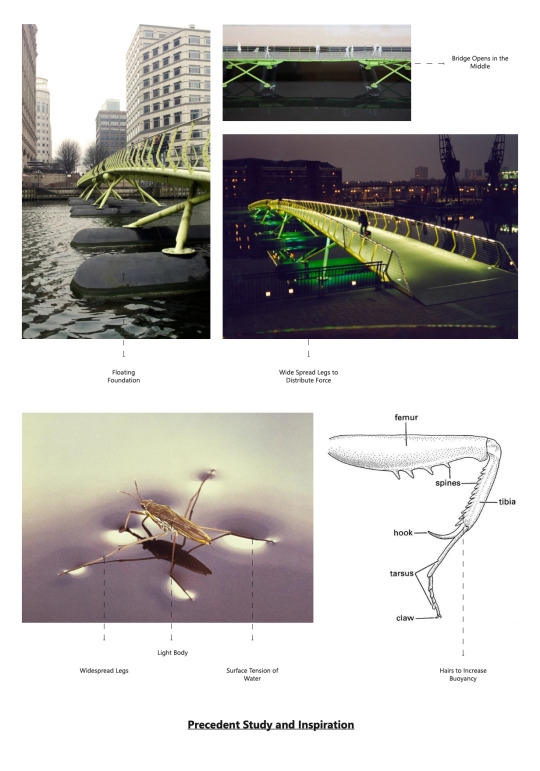





DP3 - Research Project - Mediator Spaces
Week 2:
I started to explore and test materials this week, by mixing plaster with sand, salt and shells in different ratios, I casted several samples of materials. Further, I used casting to explored the idea of having Tribo-Panels connected to the skin of the building space to potentially generate energy. I should make more samples for structural testings next week, keep investigate different mixtures to find the optimal one, (having oysters as a protective sacrificial layer), and do more literature reading on the mechanical theory of the energy systems.
Inspired by the floating bridge and insects, I designed aero-limbs systems for the first buildings space, I should iterate on this design and explore the possibility of using anchors to support the buildings.
I also communicated the idea of buildings space 1, gathering space for oysters and salt erosion, through an axo; and the organisation of spaces. The idea is to have different circulation systems in the building to guide people through differently during high tide and low tide, the bunker lab would study how hostile environment would affect different people's behavior (e.g. small scale simulation space to get people's arm trapped). I will layer another layer of iterated plan next week in more details. The spaces can be more Interlocked as well.
Notes:
Measurable info for maps: Overview, zoomed in and section of high and low tides
research architectural projects in Blackpool
Archaeological maps of samples collected
Bigger social and env. responsibility of project
Labs to map different parts of the area
sacrificial and protective layer with structural core
Part static building with part buoyant
Lost Pier, fast moving Sands
shells with plaster to take more loads?
Literature study of energy systems
Making quicksand model
Using plastics bags to visually test wind
Torch for sun-path study
Orthographic and Stareographic of sunpath
Retreating Village, Smout Allen
Walters Yard, London
Arctic Research Station, icecap melting
Hugh Broughton, Axo
12 notes
·
View notes
Text
Weep Holes: An Essential Component For Structural Integrity

The world of construction methodologies is vast, dynamic, and continuously evolving. Among the myriad of procedures and mechanisms crucial to the development of robust structures, a particularly crucial yet often overlooked feature is the ‘weep hole.’ In this blog, we delve deeper into what weep holes are, focus mainly on their application in cinder block structures, reasons for their installation near the footing, and the benefits that they provide related to relieving water trapped within a structure.
To begin with, let’s establish what Weep Holes are. Weep holes, as the name suggests give an image of something that exudes, seeps out, or, indeed, weeps. In construction parlance, they are purposely drilled in a structure to allow the movement of water or to let it escape from within.
Though these holes can be integrated into several types of structural system, their use is widely popular in cinder block constructions. Cinder blocks, also known as concrete masonry units, are commonly used in residential as well as commercial construction due to their affordability, strength, and insulation properties. Their design usually involves hollow cores, or cavities, that can unintentionally trap water within. Whether it’s from groundwater, landscape irrigation, or rainfall, the cinder block can host this water, giving birth to many potential issues such as mold, mildew, efflorescence, or even structural failure if water freezes and expands.
Therefore, to alleviate these concerns, weep holes are drilled into the cinder blocks, typically in the bottom row and near the footing. Placed lower down because water tends to flow to the lowest point due to gravity, these openings play a vital role in the overall health and longevity of the structure.
When water is present in the hollow cavities of the cinder block, the weep holes facilitate an escape route. But it isn’t just about aiding drainage; these holes also play an essential part in the structure’s ventilation, helping trapped moisture to dry up more quickly.
One might wonder–why near the footing? The footing of a building is the lowest part of the structure, usually installed below ground level. For blocks near the footing, water accumulation is most likely due to their proximity to the ground. To prevent rising dampness creeping up into the structure and ensure optimal effectiveness, weep holes are strategically drilled near the footing.
One concern that often arises about weep holes is the threat of small creatures or pests entering through them. To prevent this, weep holes are generally covered with plastic, steel, or another type of mesh to allow water escape but deter critters.
Let’s sum up the importance of weep holes: They are not a construction afterthought but an essential design feature engineered to prolong and conserve the structural integrity of cinder block structures, whether they be a garden wall, chicken coop, house, or commercial building. By simultaneously promoting ventilation and facilitating the drainage of trapped water within the cinder blocks’ hollow cavities, weep holes help to prevent the onset of undesirable moisture issues, water damage, and structural instability.
So the next time you come across some random, small holes in a structure, remember, they aren’t gaps in design or construction; they’re mitigating water damage one drop at a time. This is the importance of an often overlooked, yet vital construction element – the weep hole.
Tagged Essential Component For Structural Integrity, Structural Integrity
#Essential Component For Structural Integrity#Structural Integrity#foundation repair#foundation solutions#foundation contractor#foundation experts#foundation repair solutions#foundation services#residential foundation repair services#foundation repair near me#foundation solution#signs of foundation problems
7 notes
·
View notes
Text
I'm sorry to all the people sore about the new packaging for Nendoroids, but some of these comments make it sound like you wouldn't have preordered, if you got the new box design that replaces all the plastic packaging with paper. o.o? Are you guys Nendoroid collectors or box collectors?
I don't know if you've heard this before, but GoodSmile figures cannot remain in the box. You're not preserving any collectibility by displaying your figures forever in the box. You're thinking of WESTERN figures and those figure producers' plastics. GoodSmile representatives have said several times, the plastic that GoodSmile uses to make their figures will DEGRADE if left unopened, in the box! The plastiziser will melt the figure surfaces and turn some platics into horrible discolorations.
Are you guys really buying articulated figures with swappable parts, to not play with them? Even my $120 scale figure, that i was afraid to touch, had swappable parts which i swapped and therefore, handled the figure, to set for optimal display.
How do you guys even have the room to keep all that plastic? I can't wait to have collapsible paper packaging, to save space, avoiding the struggle to throw it all away and wonder if it'll even get recycled. Some of you may have the money to buy all your figures and all the space you want. But some of us are just barely scraping together money for just the figures and can't afford to just get more storage/living space, just for packaging. I would love to just keep all my packaging, in case i decide to sell some of my figures in the future, but a lot of us have limited space and have to make tough choices.
Companies have to stop producing so much plastic. We still need plastic for our figures to be made out of, and if something needs to be cut, I'd rather it be the packaging. Recycling isn't working, and has been proven to be a scam in a lot of cases. China is no longer buying the world's trash to process or recycle. Japan has started new laws in 2022, to reduce plastic packaging by 2030 and become plastic-free by 2050. What do you expect to happen? For Good Smile Company to break the law, just so we can display their figures in the box---which will destroy the figures anyway? GoodSmile is not Tokyu or Mitsubishi. They don't have the power to bend laws to their whims.
I'm not looking forward to the bootlegers who will try to scam us with opaque boxes, either. But we'll just have to come up with new tactics to circumvent them. In fact, do we really need new tactics? Lots of scale figure collectors and plastic model kit/gunpla collectors have been navigating bootlegs, despite opaque boxes, for years. Maybe we can just learn from them, ask them how they do it. I for one, plan to just buy from officially licensed partner shops and directly from figure producers, as much as i can, just to make sure. But i was already doing that. They even have yearly sales, so i dont want to hear complaints about getting locked into high prices, from avoiding secondary markets. Ever go to the Bandai/Bluefin warehouse sales? Check out Kotobukiya's KotoUS shop during Black Friday? Or GoodSmile's 2-3 insanely low sales every spring? Even the officially licensed secondary-market partner shops have sales. These new, plastic-free-packaging boxes are not the end of avoiding getting scammed by bootlegs. We just have to learn to navigate our new world's rules.🐔
I'M the one who has to deal with that packaging. Me, the end user, the collector. This is beyond "preformative environmentalism", "greenwashing" or a "marketing spin so GSC can cut costs and raise profits". I don't have room for all this non-collapsible plastic! Of course, i dont want to throw any part of my collections away! I'm extremely sentimental! But if the packaging were collapsible, less, and just smaller, then i wouldn't have to deal with this struggle to let go of packaging into the trash, in the first place!
Let the packaging evolve! They will refine the design until it's effective in all the ways we need. In case you haven't noticed, GSC has already been changing their box/packaging designs for years, and we all survived. And regardless of whatever images of flimsiness the word "paper" bring to mind, there are designers who actually know what they're talking about, who know better than non-experrts, about how sturdy paper can me manipulated to be. Paper can be molded into non-collapsible clamshell bubble packaging, if you want that so badly. Paper does not automatically equate flimsy.

6 notes
·
View notes
Text
Efficient Crate Washing & Drying Systems – Maximize Hygiene and Save Time in Your Operations
If you’re looking to optimize your crate cleaning process, our crate washing and drying equipment offers an industrial-grade solution that delivers fast, reliable, and hygienic results. Perfect for companies in food processing, manufacturing, logistics, and warehousing, our equipment ensures crates are thoroughly washed, sanitized, and completely dry with minimal effort.
After using this equipment for several years, we've seen firsthand how it revolutionizes crate management—boosting productivity, reducing labor costs, and ensuring cleanliness every time.
🌟 Why Choose Our Crate Washing & Drying Equipment? High-Efficiency Cleaning: Designed to remove dirt, grime, oils, and residues using high-pressure washing, ensuring your crates are hygienically clean.
Automatic Drying System: The integrated hot air drying tunnel guarantees your crates are dry and ready to reuse instantly.
Built for Durability: Constructed with stainless steel, making it corrosion-resistant, easy to clean, and long-lasting.
Customizable Settings: Whether you're dealing with plastic, metal, or composite crates, our equipment offers flexible settings tailored to your needs.
Energy & Water Saving: Advanced technology ensures your operations are eco-friendly and cost-efficient, reducing both energy and water consumption.
Scalable for Any Size Operation: Whether you’re a small business or a large industrial facility, our systems are designed to meet your specific needs.
💼 Perfect For: Food & Beverage Manufacturers who require fast, effective crate cleaning to maintain strict hygiene standards.
Logistics & Warehousing Operations that need to clean crates in bulk quickly.
Agricultural Businesses where crate cleanliness is essential for maintaining quality standards.
Meat & Dairy Processing Plants that need high-grade sanitation.
⚡ Benefits of Using Our Crate Washer & Dryer: Consistency & Reliability: Achieve uniform cleaning and drying results every time, avoiding contamination or cross-contamination between batches.
Time-Saving: Automating the washing and drying process reduces labor and time spent on manual crate cleaning.
Easy Maintenance: Built to be low-maintenance and easy to clean, ensuring long-term use with minimal hassle.
Increased Hygiene: Ideal for maintaining hygiene standards in regulated industries like food and pharmaceuticals.
🌱 Eco-Friendly & Cost-Efficient: Our crate washing systems are designed to be energy-efficient, reducing operating costs while maintaining high performance. The water and energy-saving features ensure that your business is doing its part in sustainability, while your crates remain spotless and dry.
📞 Contact Us Today! On Our Website ℹ️ For or more information, watch the video on our Youtube Channel
Ready to upgrade your crate washing process? Let us help you choose the perfect washing & drying solution for your business. Contact us now for a free quote, product demo, or consultation to see how our equipment can transform your operations.
#AutomaticCrateWasher#CrateDryerMachine#IndustrialCrateWasher#FoodGradeCrateWasher#HighPressureCrateWasher#CommercialCrateCleaningEquipment#CrateWashingEquipmentWithDryingTunnel#AutomatedCrateWashingAndDryingSystem#HACCPCompliantCrateWasher#BajajMachine#BajajMachines#BajaMachine#CrateWashingMachineNearMe#CrateWashingAndDryingMachineManufacturerNearMe#agriculture
2 notes
·
View notes
Text
Why Design for Injection Molding (DfIM) Is Critical for High-Quality Plastic Parts
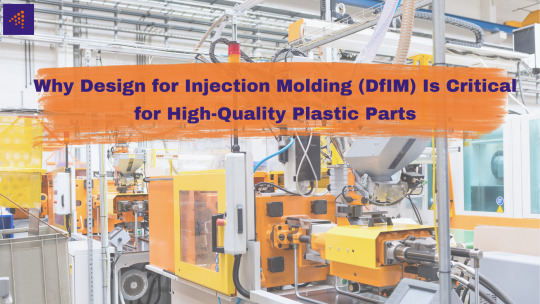
Imagine investing months into designing a groundbreaking plastic component—only to discover during production that it warps, cracks, or simply can’t be molded efficiently. This nightmare scenario is all too common when Design for Injection Molding (DfIM) is overlooked. In industries ranging from medical devices to automotive manufacturing, achieving high-quality plastic parts isn’t just about aesthetics or functionality—it’s about ensuring every step of the process, from design to production, aligns seamlessly.
Design for Injection Molding (DfIM) is the secret weapon that transforms good ideas into great products. By integrating principles like plastic part design optimization and leveraging expert injection mold design services, DfIM ensures your parts are manufacturable, cost-effective, and built to last. In this in-depth guide, we’ll explore why DfIM is indispensable, how it applies to specialized fields like DFM for medical devices, and why partnering with a design and manufacturing company—such as Aprios—can make all the difference. Let’s get started.
What Is Design for Injection Molding (DfIM)?
At its core, Design for Injection Molding (DfIM) is a strategic approach within the broader discipline of Design for Manufacturing (DFM). It focuses on tailoring plastic part designs specifically for the injection molding process—one of the most versatile and widely used methods for producing precise, repeatable components. DfIM isn’t just about making a part look good on paper; it’s about anticipating how that design will behave when molten plastic is injected into a mold under high pressure.
The process begins with understanding the unique demands of injection molding: material flow, cooling rates, and mold release. Whether you’re crafting a simple consumer product or a complex component requiring DFM for medical devices, DfIM ensures your design is optimized for production. This might mean adjusting wall thickness, adding draft angles, or rethinking feature placement—all part of plastic part design optimization.
Industries like healthcare, automotive, and electronics rely on DfIM to bridge the gap between creativity and practicality. By working with plastic injection mold design services, companies can avoid costly redesigns and bring their products to market faster. In short, DfIM is the foundation of efficient, high-quality plastic manufacturing.
Why DfIM Is Critical for High-Quality Plastic Parts
Injection molding is a high-stakes game. With pressures reaching thousands of PSI and cycle times measured in seconds, there’s little room for error. A poorly designed part can lead to defects like sink marks, warping, or incomplete fills—issues that compromise both quality and profitability. Here’s why Design for Injection Molding (DfIM) is essential for delivering high-quality plastic parts:
Defect Prevention: Uniform wall thickness is a cornerstone of DfIM. Uneven walls can cause uneven cooling, leading to stresses that distort the final part. Proper draft angles—slight tapers on vertical surfaces—make ejection easier and reduce surface imperfections. These details, often refined through injection mold design services, are what separate a flawless part from a flawed one.
Material Efficiency: Choosing the right resin is only half the battle; DfIM ensures the design maximizes that material’s potential. For instance, a part with excessive thickness wastes material and increases cooling time, while a thin, optimized design—crafted with design for manufacturing solutions—balances strength and efficiency.
Cost Savings: Every iteration of a mold or design tweak costs time and money. By incorporating DFM services early, DfIM minimizes trial-and-error, reduces scrap rates, and shortens production timelines. The result? Lower costs without sacrificing quality.
Consider a real-world example: a manufacturer designing a plastic housing for an electronic device. Without DfIM, they might overlook shrinkage rates, leading to parts that don’t fit their assemblies. With DfIM, they’d account for this upfront, ensuring a perfect fit every time. Across industries, high-quality plastic parts owe their success to this meticulous approach.
DfIM in Action – Key Principles and Best Practices
To truly harness the power of Design for Injection Molding (DfIM), designers must adhere to a set of proven principles. These aren’t just guidelines—they’re the building blocks of manufacturability. Here’s a closer look at the essentials, along with practical applications:
Avoid Sharp Corners and Undercuts: Sharp edges disrupt resin flow and create stress concentrations that can crack under load. Rounding corners improves mold filling and strengthens the part. Similarly, undercuts—features that trap the part in the mold—complicate ejection. Injection mold design services can suggest alternatives, like side actions or redesigns, to keep things simple.
Optimize Ribs and Bosses: Ribs add strength without excessive material, but they must be thin (typically 50-60% of wall thickness) to avoid sink marks. Bosses, used for screws or inserts, need proper spacing and support. These tweaks, part of plastic part design optimization, ensure durability without overcomplicating the mold.
Incorporate Proper Tolerances: Injection molding requires tighter tolerances than, say, 3D printing. DfIM aligns tolerances with the process’s capabilities—typically ±0.005 inches for precision parts. Collaborating with plastic injection mold design services ensures these specs are realistic and achievable.
Take a plastic gear as an example. A DfIM-optimized design might feature rounded tooth profiles, consistent thickness, and a slight draft for easy release—making it both functional and mold-friendly. These best practices, refined through design for manufacturing solutions, turn concepts into production-ready realities.
DfIM for Specialized Applications (e.g., Medical Devices)
When precision and reliability are non-negotiable, DFM for medical devices elevates DfIM to a whole new level. Medical components—like syringe barrels, catheter housings, or implant casings—must meet stringent regulatory standards (e.g., FDA or ISO 13485) while performing flawlessly in life-or-death scenarios.
Here, DfIM goes beyond basic manufacturability. It considers biocompatibility (ensuring materials won’t harm patients), sterilization compatibility, and microscopic tolerances. For instance, a poorly designed mold draft could leave burrs on a surgical tool, posing a contamination risk. DFM development services address these challenges by integrating regulatory insights into the design phase.
A practical case: designing a plastic inhaler component. DfIM ensures airtight seals and smooth surfaces for patient safety, while design for manufacturing services validate the design against medical standards. This specialized focus makes DfIM indispensable for industries where failure isn’t an option.
How Design and Manufacturing Companies Support DfIM
Bringing a plastic part from sketch to shelf is no small feat, and that’s where a design and manufacturing company shines. Companies like Aprios offer a suite of DFM services that amplify DfIM’s impact:
Plastic Injection Mold Design Services: Crafting molds tailored to your part’s geometry, material, and production volume. A well-designed mold can handle millions of cycles without wear.
Prototyping and Testing: Before committing to full production, prototyping—often via 3D printing or soft tooling—lets you validate DfIM principles. Adjustments here save headaches later.
DFM Analysis: Using simulations and expertise, injection mold design services identify potential issues—like resin flow bottlenecks or cooling inefficiencies—early in the process.
For example, a company developing a plastic automotive bracket might turn to design for manufacturing solutions to refine rib placement and test mold durability. The result is a part that’s lighter, stronger, and cheaper to produce. With expert support, DfIM becomes a competitive edge.
Common DfIM Mistakes to Avoid
Even seasoned engineers can trip over DfIM pitfalls without proper guidance. Here are the most common mistakes—and how DFM services can help you steer clear:
Ignoring Shrinkage Rates: Different plastics shrink at different rates (e.g., ABS at 0.5-0.8%, nylon at 1-2%). Failing to adjust for this distorts dimensions. Plastic injection mold design services calculate shrinkage upfront.
Overcomplicating Designs: Adding unnecessary features—like intricate textures or redundant supports—increases mold complexity and cost. Simplify with plastic part design optimization.
Skipping DFM Reviews: Rushing to production without a design for manufacturing services review risks missing flaws—like inadequate venting—that cause defects.
Picture a phone case with an overly elaborate logo. Without DfIM, it might stick in the mold or show burn marks from trapped air. A quick DFM check could streamline the design, saving thousands in rework. Prevention, powered by expertise, is always cheaper than correction.
Conclusion
Design for Injection Molding (DfIM) isn’t just a step in the process—it’s the backbone of producing high-quality plastic parts that meet performance goals and budget constraints. From DFM for medical devices to everyday consumer goods, DfIM ensures your designs are manufacturable, efficient, and built to impress. By embracing plastic part design optimization, avoiding common pitfalls, and tapping into design for manufacturing solutions, you’re setting your project up for success.
At Aprios, we specialize in turning your ideas into reality with expert plastic injection mold design services and comprehensive DFM development services. Don’t leave quality to chance—contact us today to discuss your next project. Let’s collaborate to create something extraordinary, from concept to completion.
#Design for Injection Molding (DfIM)#DFM for Medical Devices#Plastic Part Design Optimization#design and manufacturing company#plastic injection mold design services#injection mold design services#dfm services#design for manufacturing solutions#dfm development services#design for manufacturing services
0 notes
Text
Vehicle Design and Manufacturing Processes
Introduction: Vehicle design and manufacturing processes have evolved dramatically over the years. From manual assembly lines to high-tech automation, the automotive industry has witnessed numerous advancements that enhance vehicle performance, safety, and sustainability. This blog explores the latest trends in vehicle design and the manufacturing processes that are transforming the industry.
Design Considerations: Designing a vehicle is a complex and multi-disciplinary process that involves engineering, aerodynamics, ergonomics, safety, and aesthetics. Engineers must consider factors like fuel efficiency, performance, and environmental impact, all while ensuring the vehicle’s safety for occupants and pedestrians.
For example, modern car designs prioritize aerodynamics to reduce fuel consumption, with sleek shapes and specialized components that minimize air resistance. Additionally, the safety of the vehicle is ensured by incorporating advanced safety systems, such as collision avoidance technologies, airbags, and crumple zones.
Manufacturing Technologies: The rise of automation has revolutionized vehicle manufacturing. Robotic arms, AI, and 3D printing are now integral to automotive production. Robotics allows for faster and more precise assembly, while AI systems help in predicting maintenance needs and optimizing production schedules.
One significant advancement is the use of 3D printing for creating prototype parts and even some vehicle components. This technology enables manufacturers to design and produce intricate parts with reduced material waste and lower costs. Additionally, automation has sped up assembly lines, allowing for mass production while maintaining consistent quality.
Sustainability: As the world becomes more eco-conscious, the automotive industry has shifted toward more sustainable practices. Electric vehicles (EVs) are at the forefront of this revolution, offering a cleaner alternative to traditional gasoline-powered cars. In addition to EVs, car manufacturers are adopting environmentally friendly materials, such as recycled plastics and plant-based composites, to reduce the carbon footprint of their vehicles.
Furthermore, energy-efficient manufacturing practices, such as using renewable energy to power factories and reducing waste, are helping the industry move toward a more sustainable future.
Future Trends: The future of vehicle design and manufacturing is exciting. One of the biggest trends is the development of autonomous vehicles, which use sensors, AI, and machine learning to navigate roads without human intervention. These vehicles promise to increase safety, reduce traffic, and improve transportation efficiency.
Modular vehicle design is also gaining traction. This approach allows manufacturers to produce customizable vehicles with interchangeable components, which can be tailored to meet different customer needs.
Conclusion: The automotive industry is undergoing a revolution, driven by innovative design principles and advanced manufacturing technologies. As sustainability becomes increasingly important and new technologies such as autonomous driving and electric vehicles take center stage, the future of vehicle design looks promising. By continuing to prioritize safety, efficiency, and environmental responsibility, the industry will continue to transform how we think about transportation.
For comprehensive information and resources on engineering topics, please visit the Engineer's Heaven website.
2 notes
·
View notes
Text
Viewers turning in for the track and field events at the Summer Games in Paris next week might just do a double-take: Instead of the usual rust-colored reddish hue, the track is purple.
The new, eye-catching color will serve as the backdrop for runners competing at the Stade de France, the country’s largest stadium, located in the northern Paris suburb of Saint-Denis. The track is made by Mondo, a company based in Alba, Italy, that has made every track used at the Olympics since 1976.
The color was mainly an aesthetic choice, as purple, blue and green make up the palette for the competition venues at this year’s games. The design actually incorporates three separate colors: lavender for the track itself, darker purple for the service areas and gray for the exterior curves at each end.
Even the glue used to adhere the track to its asphalt base—2,800 pots in total—is purple, just in case any becomes visible.
“The big part of the job was to come up with a track that was different from what we had seen … to go a little bit outside the box,” says Alain Blondel, an Olympic decathlete who now serves as the sports manager for the Paris games, to Olympics.com’s Nicolas Kohlhuber.
This is the first time an Olympic track has been purple. But it’s not uncommon for athletics venues around the world to play around with color. For example, since 1986, Boise State University has famously eschewed the traditional green-colored turf for its football field, opting instead for a shocking shade of bright blue.
Color aside, the Paris track is unique for several other reasons. For one, it incorporates the shells of bivalve mollusks, like mussels and clams. Ahead of the games, track-maker Mondo began partnering with a mussel farming and fishing company called Nieddittas to give used shells a second life.
Staff at Nieddittas harvest, clean and prepare the shells—which are made primarily of calcium carbonate—so they can be ground into a powder that can be incorporated into the track material. The shells would have otherwise been headed to a landfill, so the process transforms waste into something useful. It also reduces the need for mining, which is how manufacturers usually obtain calcium carbonate.
All told, 50 percent of the Paris track comes from recycled materials, reports BBC’s Padraig Belton.
This innovative use of recycled natural materials aligns with the goals of the International Olympic Committee, which vowed to make the Summer Games in Paris the most sustainable Olympics yet. Other sustainability efforts include bike parking at many venues, more plant-based food options for spectators, 100 percent locally sourced renewable energy, a geothermal cooling system at the Olympic Village and aquatic center seats made from recycled plastic bottle caps, among many others.
The track’s design and materials may also help athletes perform their best. The Paris track has the same base as the one used at the 2020 Summer Games in Tokyo, with some minor modifications, per reporting by Reuters’ Manuel Ausloos and Vincent Daheron. At those games, athletes set three world records and 12 Olympic records—and officials expect even more records to fall next week in Paris.
“The first indications are that it will be a very, very good track,” Blondel told the Associated Press’ (AP) Jerome Pugmire in April. “If we see athletes with personal bests on the scoreboard, it means we did a good job.”
For this iteration of the track, Mondo researchers improved upon the new polymeric material first introduced in Tokyo. They also used computer algorithms to further refine the optimal shape and size of the air bubbles within the lower layer of the track, which help absorb and then rebound the energy from the runner’s foot striking the ground.
The vulcanized rubber provides good grip and resistance for Paralympic athletes who use wheelchairs and prosthetics. The track has also been specially designed to complement the latest generation of running shoes.
“For the track, we only see the aesthetics, but there is great work that goes into the underlayer,” says Alessandro Piceli, a research and development manager at Mondo, to the Guardian’s Sean Ingle.
Mondo leaders say the Paris track will be 2 percent faster than the one used in Tokyo, per the BBC. But, in 2020, runners also got a boost from hot temperatures and new shoe spike technology, per the Guardian. It remains to be seen how the track will affect athletes’ times, but its creators are confident we will see records fall in Paris.
“The athletes will find this track to be more reactive and better suited for their competition,” said Maurizio Stroppiana, vice president of Mondo’s sport division, to the AP’s Andrew Dampf and Luca Bruno in March.
#current events#olympics#sports#athletics#environmentalism#technology#2024 olympics#france#paris#shells
3 notes
·
View notes
Text
The Science of Writing Instruments: How Design and Materials Affect Your Writing Experience
Writing instruments are an essential part of our daily lives, whether we're taking notes, signing documents, or engaging in creative projects. But have you ever wondered how the design and materials of a pen or pencil influence your writing experience? From comfort and ink flow to durability and performance, every aspect of a writing instrument is meticulously crafted to ensure an optimal user experience. In this article, we’ll explore the science behind writing instruments and explain how their design and materials impact comfort, writing flow, and longevity.
1. The Importance of Ergonomics: Comfort and Grip
One of the key factors that determines how enjoyable and comfortable a writing instrument is lies in its ergonomics. Ergonomic design refers to how the pen or pencil fits in your hand and how it reduces strain during use. A well-designed writing instrument can minimize hand fatigue, especially during extended writing sessions.
Barrel Shape and Thickness
Thicker barrels are often favored by those with larger hands or for those who tend to grip their writing instrument tightly. The larger surface area helps distribute pressure more evenly, reducing strain on the hand.
Slimmer barrels, on the other hand, are ideal for people with smaller hands or a lighter writing grip, offering more control and precision.
Many modern pens, like the Pilot Dr. Grip or Uni-Ball Jetstream, are designed with cushioned grips to enhance comfort. Pens with textured or rubber grips also provide a more secure hold, preventing slippage and allowing for better control while writing.
Weight Distribution
The weight of a writing instrument and how that weight is distributed can significantly affect the writing experience. A well-balanced pen, where the weight is evenly distributed, helps maintain a natural hand posture, reducing wrist strain. Metal pens, such as those made of stainless steel or aluminum, often have a heavier feel, giving a sense of control and precision. However, for extended use, lightweight materials like plastic or composite resins are preferred for reducing hand fatigue.
2. Ink Technology: The Heart of the Writing Experience
Ink type and flow are critical components that determine how smoothly a pen writes. Different types of ink have unique properties that impact both the writing experience and the durability of the pen's output.
Ballpoint Ink (Oil-Based)
Ballpoint pens use oil-based ink, which is thicker and dries quickly on the page. This ink type is less likely to smudge, making it ideal for everyday use, especially when quick writing is needed. However, the thicker consistency requires more pressure to be applied when writing, which can lead to hand strain over long periods.
Impact on Writing: Requires more pressure but offers clean, smudge-free writing.
Durability: Long-lasting ink that is less prone to fading.
Gel Ink (Water-Based)
Gel pens use water-based ink combined with pigments, offering a smoother writing experience and more vibrant colors. The ink flows easily, requiring less pressure, making these pens a favorite among students and artists. The downside is that gel ink can take longer to dry and may smudge, especially for left-handed writers.
Impact on Writing: Smooth, easy flow with minimal pressure required, making it ideal for long writing sessions.
Durability: Vivid colors but can smudge if not handled carefully. Fade-resistant in most cases.
Fountain Pen Ink (Liquid-Based)
Fountain pens use liquid ink, which flows naturally due to gravity and capillary action. This creates an effortless writing experience with no need to apply pressure. Fountain pens are often chosen for formal writing or calligraphy due to the elegance and fluidity they bring to handwriting. However, liquid ink is more prone to smudging and requires special paper to prevent bleeding.
Impact on Writing: Extremely smooth and fluid, allowing for expressive writing styles.
Durability: Requires more care; ink may fade over time or smudge if not allowed to dry properly.
Rollerball Ink (Liquid-Based)
Rollerball pens combine the convenience of a ballpoint mechanism with liquid-based ink, resulting in a pen that offers the smoothness of a fountain pen but with more controlled ink flow. The writing experience is smooth and requires minimal pressure, making rollerball pens ideal for long writing sessions or for those who prefer a fluid, easy glide.
Impact on Writing: Effortless writing, with less pressure needed than a ballpoint.
Durability: Similar to fountain pens, rollerball ink can smudge but generally dries faster.
3. Nib and Tip Design: Precision and Flow Control
The design of the nib or tip is crucial for controlling the ink flow and determining how a pen interacts with the paper. The choice between fine, medium, and broad tips impacts how smooth, controlled, or bold the writing experience feels.
Ballpoint Tips
Ballpoint pens have a small metal ball (usually stainless steel or tungsten carbide) that rolls as you write, distributing ink onto the page. The ball size determines the thickness of the line, with finer points (0.5 mm or less) creating more precise lines, while broader points (1.0 mm or larger) are ideal for bold writing.
Fine-tipped pens provide better control for small, detailed handwriting.
Broad-tipped pens deliver a smoother experience but are better suited for larger, bold handwriting.
Fountain Pen Nibs
The nib of a fountain pen is highly customizable, ranging from fine to broad, and even flexible or italic nibs for different writing styles. Gold or stainless steel nibs are commonly used, with gold nibs offering more flexibility and softness while writing. The design of the nib allows for varying line widths depending on the pressure applied, making fountain pens ideal for creative writing or calligraphy.
Impact on Writing: Can create expressive and variable strokes, depending on pressure and nib type.
4. Material Durability and Longevity
The materials used in the construction of a pen or pencil play a significant role in its durability and lifespan. Here are some common materials and their benefits:
Plastic: Lightweight and affordable, plastic is the most common material for everyday writing instruments. It’s durable enough for frequent use but less long-lasting compared to metal pens.
Metal (Aluminum, Brass, Stainless Steel): Metal pens offer superior durability and often have a more premium feel. They are resistant to wear and tear, making them ideal for long-term use, although they tend to be heavier.
Wood (for Pencils): Wooden pencils are biodegradable, making them an eco-friendly option. High-quality pencils like Faber-Castell or Staedtler use sustainably sourced wood, ensuring durability and environmental responsibility.
Conclusion
The design and materials of writing instruments go far beyond aesthetics, directly influencing comfort, writing flow, and durability. Whether you're choosing a ballpoint pen for quick notes or a fountain pen for elegant letters, understanding how these elements work together can help you select the right tool for your writing needs. By paying attention to ergonomics, ink technology, nib design, and materials, you can enhance your overall writing experience and find the perfect instrument for your style.
2 notes
·
View notes
Text
Which Warehouse Does Your Business Need?

You need a warehouse.
You have pinpointed the most optimal location and finalised on all the high-tech equipment and machinery to function with ease, but how do you decide which warehouse building is best suited for your operations and functions? Let’s find out.
The Standard Warehouse
For operations that only need basic walls, a roof and some clear space, the standard warehouse is the way. These warehouses can be made in any size required and are extremely versatile.
It is possible to fit them with skylights and windows as well as with multiple gates, ramps and docks. They are a popular solution for almost every industry, providing storage for machines, raw materials and equipment, and products in production; serving as transshipment points in logistics; storing goods for retailers and wholesalers; acting as distribution centres for e-commerce; and even housing donations and relief supplies for non-profit organisations.
A standard warehouse can be easily adapted to specific equipment and spatial requirements by the warehouse developer and are extremely cost effective for businesses that require minimal retrofits to get going.
The Container Warehouse
This is a specific kind of storage warehouse is a stopover for goods coming or going from freight transport. These warehouses are used to consolidate or deconsolidate freight goods to prepare them for the next legs of their journey. Or in other words, it is a temporary storage for the goods to wait a little for other goods to come and fill a container up, before they can be shipped off. The challenge here is to have a system that allows storing, tracking and retrieving the goods easily and efficiently.
Container warehouses need to be located close to ports, airports, or major railway hubs. These warehouses can be designed for efficient cross-docking and provision can be made for ample parking space for holding trucks even in case of demand surges. These warehouses are also equipped with stacking racks, crane systems, container frames, floor anchors, proper lighting, and robust security systems.
The Open-Air Warehouse
For large and heavy items that are difficult to move in and out of warehouse dock doors, open-air warehouses provide an efficient storage solution. Custom-designed racks for open yard storage can offer protection from atmospheric elements and play a key role in keeping the goods safe. Typically, the warehouse is an open area with space demarked and fenced in with walls with a high level of security to safeguard the assets.
Depending on the sensitivity of the goods and the extremities of the climate, storage can be covered or partially roofed. Goods are also protected by covering them in plastic wraps or tarps. These warehouses are commonly used to store vehicles, spare parts, machines, and raw materials for construction, metalworks, or timber sectors. The design of open-air warehouses focuses on shielding goods from harsher natural elements like direct sun or snow but may not address milder elements like humidity, wind, dust, and temperature fluctuations.
The Industrial Warehouse
This is the modern-day factory which may span across multiple halls and floors and can be tailored to integrate advanced technology and equipment. The industrial warehouse can be designed to have spacious loading and unloading areas; ample space for machinery, equipment, goods, and workplaces; high ceilings and large doors for the transporting of goods and large machines, even indoors; bright administrative and office areas; parking spaces for delivery and staff vehicles; pleasant social and relaxation areas for the workers; strong load-bearing floors; a reliable energy supply and ventilation; independent lighting systems for each work area and fire protection measures like fire alarms, smoke detectors, and fire extinguishers.
These warehouses are especially popular for manufacturing companies, energy and utility companies and businesses in the food and beverage industry.
The Custom-Made Warehouse
When your business needs are too complex to be housed in a pre-made standard warehouse, you need a warehouse designed around your requirements. These are called built-to-suit warehouses. They provide a high degree of customisation and can be made to create the ideal environment needed for your operations and goods.
Need a cold storage with consistent temperature and humidity, immaculate hygiene and protected electrical circuits? It is possible. Need a chemical warehouse with good ventilation systems, fire containment measures and specialised storage? Also, possible. Retail warehouses with space for smart racking and processing machines, auto warehouses with complex assembly lines or heavy industry that need tall lifting equipment and sturdy densified floors, a custom-made warehouse lacks for nothing.
The Automated Warehouse
If you are a business that uses machines to do it all, then an automated warehouse is what you are looking at. These are computer-controlled environments with automated racking and shelving, conveyor and retrieval systems. While the investment cost is definitely high, the efficiency is unmatched. These warehouses are sought by large trading companies, global e-commerce giants, logistics parks in India and manufacturing behemoths.
At the end of the day, you know your business needs better than anybody. It is crucial thus, to find a warehouse developer who is proactive in understanding your functional requirements and who works with you to overcome any infrastructural challenges in a collaborative way. At Horizon Industrial Parks, our teams specialise in delivering custom-made warehouses as well as providing swift plug-and-play solutions that can get your operations running in no time. To learn about what our customers like about us, click here, and visit our website to connect with us for exploring collaboration opportunities.
#warehouse#business#ecommerce#supply chain management#manufacturing#automobile#last mile delivery#logistics#real estate
2 notes
·
View notes
Text
I know this is going to sound like a really weird idea, but let me explain:

Paralyves has a visual design that's somewhere between 3D anime, Borderlands, and paper dolls. If you grew up in a shitty country or poor family like me, you probably also find this style more familiar than the rich plastic Barbie-vaudeville of the American suburbia of The Sims 4. Did you have paper dolls with their paper clothes that you put on by folding the pieces on the sides? And did you draw most of the clothes yourself? And did you draw their house in a cheap notebook?

If not, ignore the above, but ask yourself if the world of Parafolk seems to be made of colored paper, like origami? Today YouTube recommended me a video about the game's development progress, which I had already seen. And I realized that the creators of Paralives should make merch, part of the sales of which will go to further development and repair of the game after its release.

The idea is this: A pack of 15-20 sheets of colored paper or cardboard (not necessarily high quality, possibly made from recycled materials and the more "lint", garbage, heterogeneity in texture, the better) for origami.

The sheets can be either painted with colored blocks, so that when assembling a three-dimensional paper figure it becomes a color-shadow, or have drawn elements. The back side of the sheet, if it is not visible when gluing the figure or assembling the origami, may not even be painted or bleached.

It is better to make the size of the sheets no larger than the area of the CD case, so that collectors can put it in their stack with physical discs of their games. An extra piece of paper insert can be added to the end of the paper packaging, which will have the signature designation of the Paralives game.

The instructions for assembling and folding the figures/origami can be placed in the public domain on the Internet, since sooner or later it will appear there anyway. I think this is the most budget-friendly way to organize a fundraiser (unfortunately, I still haven't figured out how to optimize people and the implementation of this garbage for a group of ten people, but I hope that their studio will grow). Please note: Glue and scissors are not included in the set.

What do you think? It doesn't sound as complicated as custom merch that could very well be expensive junk (like a bottle of Todd Howard's cola). But it's an interesting enough idea to make me interested in buying it (cost of paper + salaries for the people + $4 of funding for an independent video game studio).

5 notes
·
View notes
Note
The missile knows where it is at all times. It knows this because it knows where it isn't, by subtracting where it is, from where it isn't, or where it isn't, from where it is, whichever is greater, it obtains a difference, or deviation. The guidance sub-system uses deviations to generate corrective commands to drive the missile from a position where it is, to a position where it isn't, and arriving at a position where it wasn't, it now is. Consequently, the position where it is, is now the position that it wasn't, and it follows that the position where it was, is now the position that it isn't. In the event of the position that it is in is not the position that it wasn't, the system has required a variation. The variation being the difference between where the missile is, and where it wasn't. If variation is considered to be a significant factor, it too, may be corrected by the GEA. However, the missile must also know where it was. The missile guidance computance scenario works as follows: Because a variation has modified some of the information the missile has obtained, it is not sure just where it is, however it is sure where it isn't, within reason, and it knows where it was. It now subracts where it should be, from where it wasn't, or vice versa. By differentiating this from the algebraic sum og where it shouldn't be, and where it was. It is able to obtain a deviation, and a variation, which is called "air"
The 757 is a low-wing cantilever monoplane with a conventional tail unit featuring a single fin and rudder. Each wing features a supercritical cross-section and is equipped with five-panel leading edge slats, single- and double-slotted flaps, an outboard aileron, and six spoilers. The wings are largely identical across all 757 variants, swept at 25 degrees, and optimized for a cruising speed of Mach 0.8 (533 mph or 858 km/h). The reduced wing sweep eliminates the need for inboard ailerons, yet incurs little drag penalty on short and medium length routes, during which most of the flight is spent climbing or descending. The airframe further incorporates carbon-fiber reinforced plastic wing surfaces, Kevlar fairings and access panels, plus improved aluminum alloys, which together reduce overall weight by 2,100 pounds (950 kg). To distribute the aircraft's weight on the ground, the 757 has a retractable tricycle landing gear with four wheels on each main gear and two for the nose gear. The landing gear was purposely designed to be taller than the company's previous narrow-body aircraft to provide ground clearance for stretched models. In 1982, the 757-200 became the first subsonic jetliner to offer longer lasting carbon brakes as a factory option, supplied by Dunlop. The stretched 757-300 features a retractable tailskid on its aft fuselage to prevent damage if the tail section contacts the runway surface during takeoff. Besides common avionics and computer systems, the 757 shares its auxiliary power unit, electric power systems, flight deck, and hydraulic parts with the 767. Through operational commonality, 757 pilots can obtain a common type rating to fly the 767 and share the same seniority roster with pilots of either aircraft. This reduces costs for airlines that operate both twinjets.
3 notes
·
View notes